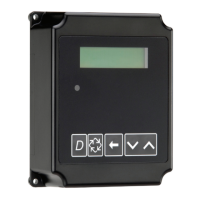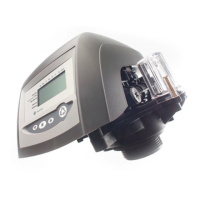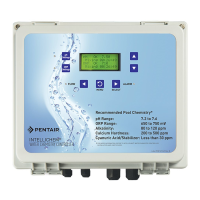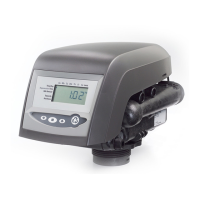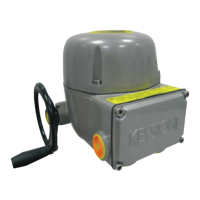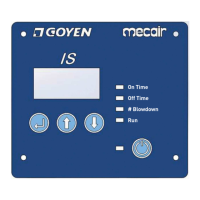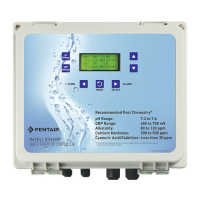123
Using the AK110 Keypad to Enter an E-mail Address
Each numeric key is associated with three
or more letters of the alphabet, or with
punctuation and other special characters.
Successive keypresses cycle through the
various characters associated with each
key. For instance, press the [5] key once
to display the number "5" on-screen.
Press it a second time (while the cursor is
in the same position) to display the letter
"J". The third keypress displays the letter
"K" and the fourth keypress displays the
letter "L". Press the key one more time to
return to the number "5".
Each of the arrow keys as well as the
[Back] and [Enter] keys perform specific
functions within the E-mail Address
Setup Screen.
Press the up arrow key to delete the
character at the cursor position.
Press the left arrow key to move the
cursor one space to the left.
Press the right arrow key to move the
cursor one space to the right.
Press the down arrow key to cancel out of
the e-mail address entry process.
Press the [Back] key to insert a blank
space at the cursor position.
Press the [Enter] key to confirm the e-
mail address as displayed on-screen.
1
C
harles.lindbergh@ac
u-trol.com
U
v-Cancel Back-Ins
1
charles.lindbergh@ac
u-trol.com U
v-Cancel Back-Ins
Moving the Cursor
E-mail Address, Upper Case Text E-mail Address, Lower Case Text
E-mail Address, Cursor to Right
1
c
harles.lindbergh@ac
u-trol.com
u
v-Cancel Back-Ins
To change between upper case and lower case letters, press the left arrow key until the
cursor is in the leftmost position, then press the left arrow key once again. The letter "U"
in the lower right corner of the display indicates whether subsequent text entered will be
lower case or upper case.
1
c
harles.lindbergh@ac
u-trol.com U
v-Cancel Back-Ins
E-mail Address, Cursor to Left
An upper case "U" in the lower right
corner of the display indicates that
letters entered in via the keypad will
be displayed in upper case.
A lower case "u" in the lower right
corner of the display indicates that
letters entered in via the keypad will
be displayed in lower case.
The cursor position is indicated by
the character "1" located directly
above the first character in the e-
mail address.
Press the right arrow key to move
the cursor one space to the right.
The cursor has moved one space to
the right and is now positioned
directly above the second character
in the e-mail address.
Press the left arrow key to return the
cursor to its previous position.
Changing between Upper and Lower Case Letters
1:moe.howard@+04
2:larry.fine@+04
3:curly.howard@+04
>
4:acu-trol.com
A single e-mail address entry may be up
to 29 characters in length. For longer e-
mail addresses, it is possible to "split" an
e-mail address between two separate
address book entries. The means of
accomplishing this is shown in Example 1
on the right. This feature also proves
useful when multiple e-mail addresses
share the same domain name.
In the second example on the right, three
highly professional pool service personnel
have e-mail addresses which share the
same "acu-trol.com" e-mail domain name.
The domain name (which comprises the
last portion of the e-mail address) is
slotted into the fourth address book entry.
Each of the three individual e-mail
recipients are given a partial entry
comprising of the first portion of their
respective e-mail addresses (do not forget
to include the "@" symbol.) Each entry
includes a numeric pointer (+04) added
the end of the address entry location
where the domain name resides.
When an e-mail is sent out to address 1,
the controller will append the user name
(moe.howard@) to the domain name
(acu-trol.com) specified by the pointer
(+04) which follows the user name.
Thus, the reconstructed e-mail address
becomes "moe.howard@acu-trol.com".
The same will be true for address entries
2 and 3.
1:john.jingleheimer
schmidt@+02
>2:acu-trol.com
3:
4:
Parsing E-mail Adress Entries
Example 2: Shared Domain Name
Example 1: Long E-mail Address
Due to John's extraordinarily long
surname, his entire e-mail address
will not fit in a single address book
entry. To work around this, the e-
mail address is split into separate
"user name" and "domain name"
entries, with a numeric pointer to
connect the two.
Moe, Larry, and Curly all share the
same e-mail domain name. It is
therefore convenient to give the
domain name an e-mail address
entry of its own.
AK110 Communications Screen for Cellular Modems (3 of 3)
Enter
Communications, Sync Byte 1 Sync Byte 1 Screen
Enter
Use the keypad to enter a number from
0 to 255. This is the second sync byte
for controller communications security.
Press the [Enter] key to confirm or the
down arrow key to cancel.
Communications, Sync Byte 2 Sync Byte 2 Entry Screen
Enter new value
Current: 204
204
v-Cancel ^
Enter new value
Current: 203
203
v-Cancel ^
Use the keypad to enter a number from
0 to 255. This is the first sync byte for
controller communications security.
Press the [Enter] key to confirm or the
down arrow key to cancel.
The Modem Diagnostics Screen
displays modem configuration data
that such as the modem initialization
string. This data is intended for use by
qualified service personnel.
Communications, Diagnostics Modem Diagnostics Screen
Modem (Cellular)
Email Test
Email Addresses
Advanced Setup
>
Diagnostics
Sync Byte1: 203
Sync Byte2: 204
at+CGATT=1 xx
48 123
Enter
Back
Shortcut to the Advanced Setup Screen
The Advanced Setup Scre en may
quickly be accessed from the
Modem Diagnostics Screen by
pressing the [6] shortcut key.
Modem (Cellular)
Email Test
Email Addresses
Advanced Setup
Diagnostics
>
Sync Byte1: 203
Sync Byte2: 204
Modem (Cellular)
Email Test
Email Addresses
Advanced Setup
Diagnostics
Sync Byte1: 203
>
Sync Byte2: 204
From Commmunications Screen
for Cellular Modems (1 of 3)
To Commmunications Screen
for Cellular Modems (2 of 3)
T U V
8 9
W X Y ZP Q R S
7
G H I
4
J K L
5
M N O
6
A B C
2
D E F
3
!$%^&*+
1
,-#.@_
0
Confirm
ENTERBACK
Insert
L
E
F
T
R
I
G
H
T
DELETE
CANCEL
6
AK110 Communications Screen for Cellular Modems, Rev 3 21 Aug 2008
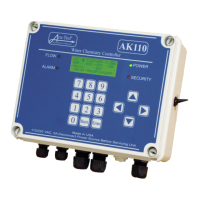
